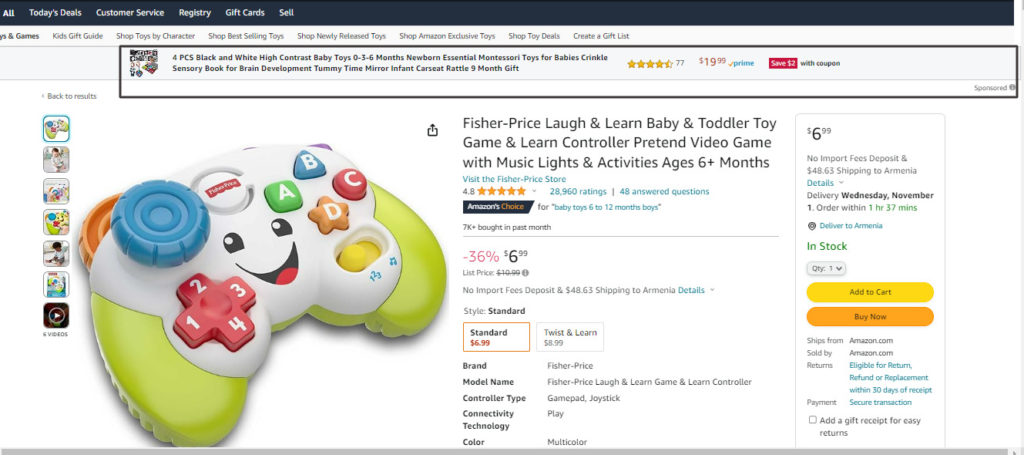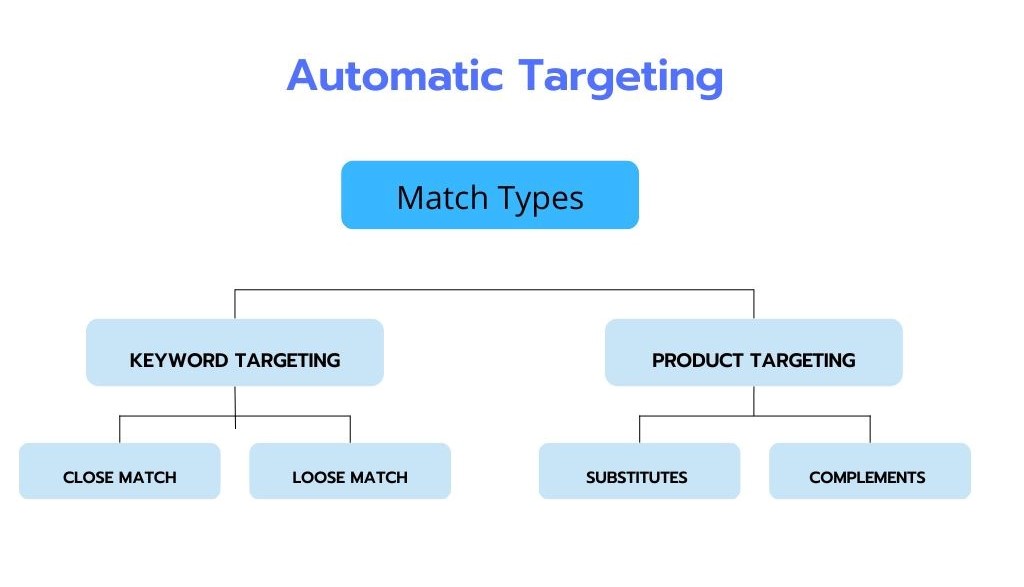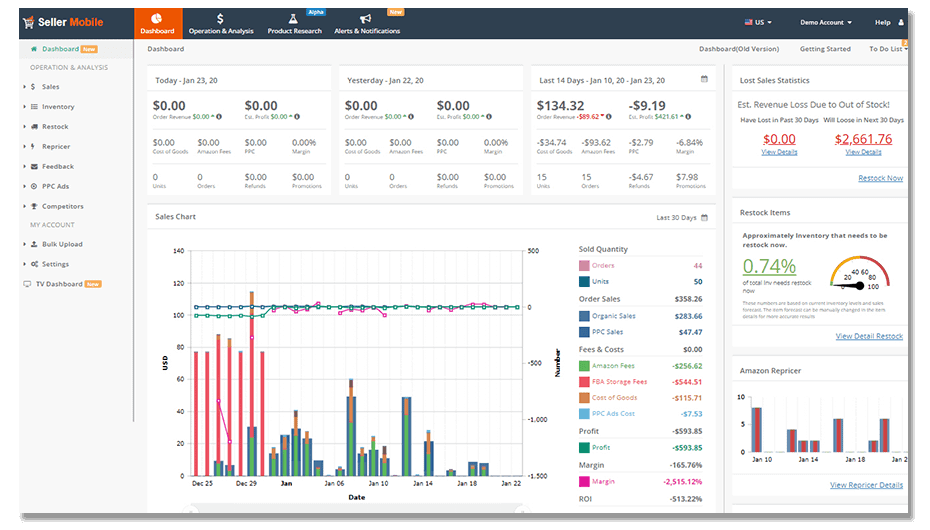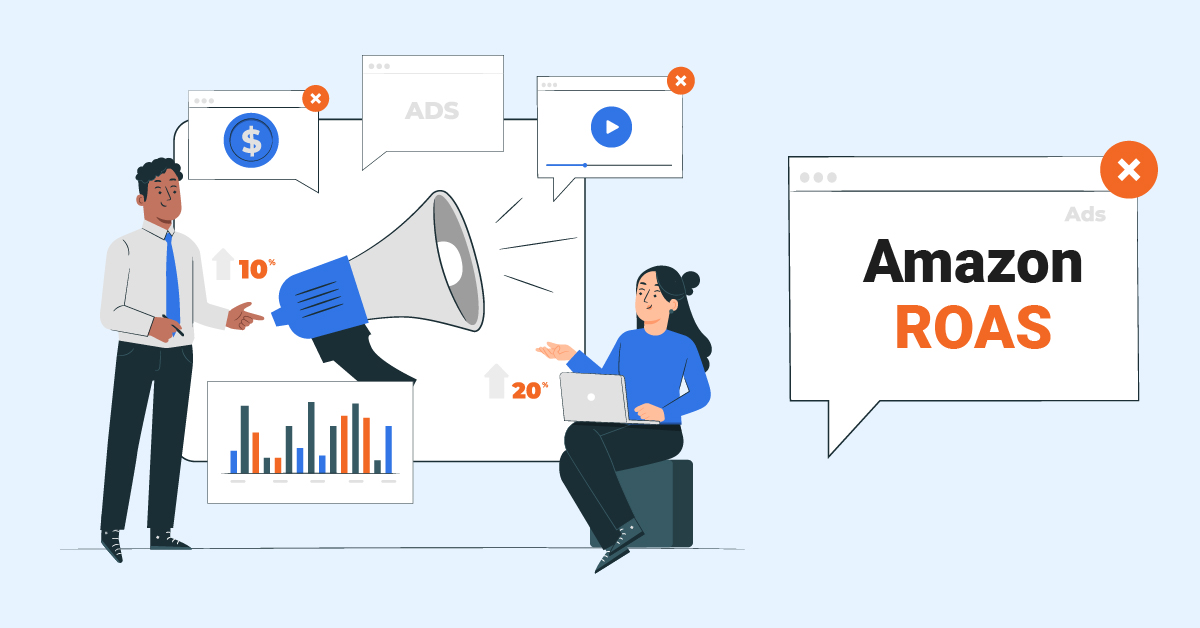Have you ever thought how important can be a single calculation for the success of your eCommerce business? It is crucial to understand the significance of Amazon ROAS (Return on Advertising Spend) to monitor profitability in the competitive environment of online retail.
ROAS is a critical metric for eCommerce businesses selling products on Amazon that measures the effectiveness of ad campaigns. The statistics clearly show how the advertising campaign may impact sales. According to the 2022 survey among Amazon advertisers, 44% of respondents said sponsored products generated the highest ROAS.
Therefore, it’s crucial to always monitor the indicators so as not to lose money. If the seller wants to make data-driven decisions, comprehensive tools like SellerMobile are here to help. The platform offers advanced features and insights to build the bestselling strategy on Amazon.
Here’s what you’ll get with SellerMobile:
This article will show how to calculate and improve ROAS using advanced software.
What Is Amazon ROAS?
It’s a vital metric showing the effectiveness of advertising campaigns for any seller operation on the Amazon platform. In other words, it provides insights into how well each dollar spent on advertising transforms into revenue generation. ROAS Amazon refers to a wide range of measurements. It can both assess the performance of an individual campaign and provide an annual evaluation of the effectiveness of the campaign.
In general, Amazon ROAS reveals whether the ads campaign is yielding profit or draining resources. It’s simple as a higher ROAS shows the advertising efforts are profitable, while a low indicator points to inefficiency in ad spend.
So, let’s see why it is important to track Amazon’s advertising ROAS.
- Profitability: Maintaining high ROAS values shows that advertising efforts are driving revenue and contributing to the bottom line.
- Optimizing Amazon Ad Spend: Once you identify the campaign that delivers the best results, it helps allocate your budget more effectively, maximizing returns.
- Scaling Growth: With a growing eCommerce business, ROAS becomes even more critical in terms of assessing the feasibility of increasing an advertising budget.
- Data-driven Decisions: Calculating ROAS empowers data-driven decision-making which helps sellers optimize their advertising strategies and run ad campaigns based on the right data.
Thus, understanding and optimizing ROAS can lead to increased profitability and is a driver of success in online retail business.
ROAS, ROI, ACoS: What’s the Difference?
There are different metrics to evaluate the performance and profitability of digital advertising on Amazon. While they share similarities, they are calculated differently and serve distinct purposes. So, let’s see what the specifics of each metric are.
ROI or return on investment provides an assessment of the overall profitability of investments. It considers all expenses associated with your eCommerce business, including office costs, staff costs, etc., to calculate the return. Since ROI requires evaluation of multiple factors, software tools like SellerMobile can help with careful planning of actions to maximize the indicators.

Compared to ROAS, it provides an overall view of business profitability measuring the total return on investment, not just advertising expenses. Moreover, ROI may include investments in inventory and vendor costs.
So, what is ROI in Amazon?
To understand this, have a look at its formula.
ROI = Profit / Advertising Spend X 100
Thus, ROAS shows a return on the campaign, while ROI provides a bigger picture taking profit into account. ROI provides insight into whether the campaign is profitable, while ROAS shows if the campaign generates revenue.
ACoS
Another metric ACoS or Advertising Cost of Sale calculates the percentage of attributed sales revenue that is spent on advertising costs. This helps Amazon sellers understand the direct impact of ad spending on product sales.
ACoS = AdSpend / AdRevenue X 100
Thus, ACoS is calculated with a focus on sales within the Amazon ecosystem. For example, if a seller spends $30 on an ad campaign and earns $300 from it, the AcOS would be 10%. When it comes to ROAS, it is expressed as a ratio such as 4:1 showing that for every $1 spent on advertising $4 was generated.
The difference between ACoS and ROAS lies in their focus and calculation. While ROAS provides an estimate of potential earnings from an ad campaign, ACoS indicates the percentage of revenue increase. Examining both metrics is valuable for the overall understanding of the campaign performance.
Return on Ad Spend Formula
Calculating Amazon ROAS is easy with a straightforward formula when you divide revenue from advertising by the amount spent on advertising campaigns.
First, the seller needs information on the total revenue generated as a direct result of advertising efforts. It’s also important to track revenue specifically tied to the campaign. Secondly, the total cost spent in running the campaign encompasses expenses related to ad placement, clicks, and impressions.
ROAS = AdRevenue / AdSpend
The higher ROAS the more profitable and efficient the ads campaign. Let’s examine a simple Amazon ROAS calculation technique. If a seller spends $400 on the ad campaign and the revenue he gets from sales is $400, ROAS would be 4.
It’s essential to constantly monitor Amazon’s advertising spending to review the strategy and make adjustments to the existing campaigns. Calculating ROAS helps understand if the money spent on a digital marketing campaign is worth it. Overall, the ultimate goal is to protect online sellers from spending too much on ads that are not bringing results.
What Is a Good ROAS on Amazon?
Each seller should determine what he believes is the best ROAS for the eCommerce business. Determining what constitutes a good ROAS is crucial, but there is no common scale for all retailers. Successful ROAS can vary depending on various factors, including the product margins, the industry, and business goals.
For example, products with higher profit margins can afford to have a lower ROAS. Besides, various industries and product categories have different levels of competition. Therefore, a good ROAS Amazon for one category may differ significantly from another. Conducting research on industry benchmarks is a good strategy to gain insights into what is typical for the specific sector.
According to Amazon, on average, the successful ROAS for a brand is somewhere between 3 and 4. Do not forget about business goals. Is a company aiming for rapid growth and accepting lower profitability or it is prioritizing short-term benefits? The main objectives influence the desired level of ROAS.
In addition, there are also marketplace factors that the seller must take into account. Highly competitive categories may require more resources and a different perspective on what is a good ROAS.
It’s also important to consider the advertising strategy to find the right balance between spending enough resources and not starting to lose money because of too many ad expenses. Thus, there is no universal recipe for all businesses. While a higher ROAS is excellent for profitability, a lower can yield results in the long run.
ROAS by Amazon Ad Products
The marketplace offers various advertising products to help sellers and brands to have successful ROAS indicators. The ads are driving traffic, increasing visibility, and boosting sales on Amazon. One of the most popular tools is Sponsored Products which promotes individual listings on the platform. This works for small and large businesses as advertisers can set their own budgets and bids. To have a good ROAS with such an ad campaign, the seller needs careful keyword selection and optimization.
Meanwhile, Sponsored Brands enable businesses to advertise their brand and products in a banner ad format.

The ads can appear below or above shopping results, or in the description of a product. In fact, these campaigns have a better ROAS when the keywords and bids are optimized.
When using analytical and reporting tools to track the results of these campaigns, you have better chances to achieve favorable ROAS levels.
ROAS by Amazon Ad Targeting Type
The level of ROAS may vary depending on campaign goals and product offerings. Amazon’s advertising platform offers different targeting options and each influences ROAS in its own way. Therefore, the seller is better at testing target match types to see which one is performing better.
In general, Amazon has four different match types for automatic targeting. Two of them – close match and loose match – are used for keyword targeting. Meanwhile, substitutes and complements target products. Close match may show better ROAS as it is focused on the keywords that are most relevant to the search intent.

ROAS varies depending on the selected campaign management. Advertisers should regularly analyze campaign performance, adjust targeting strategies, and allocate budgets wisely. In this case, they will maximize ROAS and overall advertising effectiveness on Amazon.
ROAS by Amazon Product Price
Even if several expensive products were sold this does not necessarily mean the ROAS will be great. The price of products impacts ROAS, and it is a critical factor that the sellers have to consider when running campaigns.
However, cheaper products are usually sold more quickly and without too many ad clicks. Meanwhile, for selling expensive goods, the online store has to spend more resources on advertising campaigns. Competition and customer expectations also play a role.
Anyway, to get good ROAS for lower-priced items, the seller also needs to optimize the campaigns to increase efficiency. These items can generate quicker sales, but the ROAS may be lower due to lower profit margins.
Changing prices and adjusting them based on demand can also impact Amazon’s advertising ROAS. For example, lowering prices during promotions can increase the return on advertising temporarily.

Pro Tips to Improve ROAS on Amazon
There are some expert-level practices for those who want to achieve a strong ROAS, which is a priority for sellers and brands. It’s essential to employ advanced strategies to remain competitive and not waste money on ad campaigns in vain.
This does not mean that the seller always must spend less resources. When launching a new product, a powerful ad campaign may be needed to get the most out of PPC. Thus, the strategy the Amazon seller chooses depends on the business goals.
One of the options is to adopt an efficient strategy by leveraging advanced software solutions. This enables the seller to make decisions based on in-depth insights. It’s your helping hand when tracking successful ROAS and other indicators.
When it comes to the right keywords, various techniques may be used to allocate the budget more efficiently. This includes utilizing negative keywords or dynamic keyword insertions to improve relevance and click-through rates. Let’s get started.
The Bottom Line: Use Advanced Amazon Seller Software to Track ROAS
When launching an ad campaign to boost sales, it’s important not to lose the point when the amount spent on advertising affects the overall profit. That is why our number one recommendation is to use tools that would make it easier to track the metrics constantly. One such powerful tool is SellerMobile, a comprehensive platform designed to increase the efficiency and profitability of Amazon businesses.

The platform offers customizable dashboards giving all insights related to product performance and analytics. In addition to real-time tracking of ROAS and other indicators, the tool helps in creating goals and benchmarks. Thus, the seller can minimize future losses by monitoring impressions of the ads received and tracking CTR and conversions.
Besides, the system compares the best and worst-performing products, which helps in optimizing future ad campaigns. The advantage is multiple data sets are available on the same dashboard. Therefore, the seller can also track ACoS and total advertising cost of sale (TACoS). There are 30+ widgets to select the right one you need for your online business.
In other words, platforms like this are a comprehensive suite of features to help the seller stay alert. If there are signs that the ad campaigns are out of control, the software notifies the user to take necessary measures.






